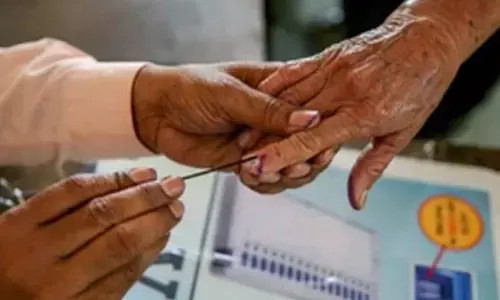Was 2019 an 'annus horribilis' for India's children?

The year 2019 witnessed many of India's children emerging as advocates and crusaders for different causes.
The year 2019 witnessed many of India's children emerging as advocates and crusaders for different causes.
There was India's Greta Thunberg, 11-year-old climate change activist Ridhima Pandey, who was among the 16 children including Greta to file a complaint at the United Nations Climate Action Summit against the lack of government action to save the environment.
There was also 17-year-old youth activist Payal Jangid, the first Indian to win the Goalkeepers Global Changemakers' Award by the Bill and Melinda Gates Foundation for her outstanding work towards abolition of child marriage in her village, Hinsla, Rajasthan, which has now been declared a child-friendly village too.
Besides the major headlines that focused on children, 2019 was an important year for Child Rights & You (CRY) as the non-profit organisation completed four decades of working towards restoring children's rights.
We have seen many children championing the cause and overcoming the hurdles in their lives like Kavita, the 17-year-old who hails from one of Delhi's most notorious areas — Shahbad Dairy, and with the help of Saksham, a non-profit supported by CRY, Kavita has honed her cricketing skills.
Today, Kavita is an emerging cricketer, who has not only played in a T20 last year but has also stumped Michael Clarke in a friendly match and moved Virat Kohli with her heroic journey.
As yet another year comes to a close and we welcome 2020, let's assess this year's major events that drew our attention and made us rethink where our children are. As the year came to a close, the rape and cold-blooded murder of an 18-year-old girl in Fatehpur, Uttar Pradesh shook us all.
The teenager was allegedly raped and set on fire by her distant relative staying next door. Another such shocker took place in January 2019 when a 16-year-old girl in Bihar's Gaya was brutally raped and beheaded. Police found the badly mutilated body and head, which was doused in acid to avert victim identification.
To deter the rising number of sexual offences against children, Parliament (in July) approved The Protection of Children from Sexual Offences (Amendment) Bill 2019, which covers a wide spectrum of crimes including child pornography.
The amended POCSO Act also provides death penalty for committing sexual assault and aggravated penetrative sexual assault against a child. However, we along with many other child rights organisations, have emphasised that death penalty is not the right solution to address the issue, and instead, we have advocated for the need of strengthening prevention mechanisms, speedy judicial procedures, rehabilitation of survivors and witness protection.
The latest NCRB data on crime in India, published after a gap of two years, reveals a 20 per cent increase of crimes against children from 1,06,958 cases in 2016 to 1,29,032 in 2017, while the overall increase of crimes in India was 3.6 per cent.
The alarming number of nearly 1.3 lakh cases in 2017 indicates that each day over 350 crimes were committed against children in India. The rate of cognizable crimes against children also rose to 28.9 in 2017 per lakh children from 24 in 2016.
Though we believe that increase in reporting of incidents is indeed a good sign as it indicates that more and more people are coming forward to report such crimes and not sweep such wrongdoings under the carpet, but a lot more needs to be done to improve the pathetic scenario of crimes against children.
Taking note of the rising number of child rape incidents and sexual abuse of minors, the Supreme Court took a suo moto cognisance as the increasing incidence is unable to match pace of the legal recourse.
In 2016, there were a total of 64,138 cases (including pending cases from previous years) awaiting court trial, but NCRB data shows that only 6,684 cases (a mere 10 per cent) were dealt with in the year.
The situation has not changed much in recent times. As reported in the media, the Supreme Court has listed 24,212 cases of child rape registered in the last six months (January-June 2019), of which trial of only 900 have been completed.
Released in October 2019, the government's Comprehensive National Nutrition Survey (CNNS) of children and adolescents was conducted between 2016 and 2018 by the Union Ministry of Health and Family Welfare and surveyed a sample of over 112,000 children in 30 states.
The report found high prevalence of stunting and wasting among children under five throughout the country. According to the CNNS, stunting affected 35 per cent of children under five and wasting affected seventeen per cent. Thirty-three per cent of children are underweight, with 35 per cent of children aged five to nine years being underweight and ten per cent being severely underweight.
Meanwhile, the survey also highlighted a significant increase in numbers of overweight children and adolescents and a concerning trend of pre-diabetes.
The CNNS report clearly stated that the current nutrition situation in India justifies its high level national commitment with strong policy initiatives based on evidence-informed interventions towards combating all forms of malnutrition in the country.
Also, in the World Hunger Index 2019, India occupied the 102nd spot out of the 117 countries, clearly indicating that significant increase in financial allocation for social sector, especially children is vital.
India ranked 102 out of 117 countries according to the Global Hunger Index 2019, while in 2018, it was ranked 103 out of 119 countries, and 83 out of 113 countries in 2000.
Essentially a vector-borne disease caused by mosquitoes, one of the factors considered to trigger encephalitis syndrome is malnutrition.
The crisis that hit Muzaffarpur and adjoining districts of Bihar in June 2019 caused the death of over 150 children due to Acute Encephalitis Syndrome (AES). However, this is not the first time that Bihar was faced with such a crisis.
The state has had a long tradition of being the epicentre of Encephalitis outbreaks, the first instance being recorded in 1995.
When the efforts towards drafting of a new national policy on education began in 2015, it was a welcome step. It brought with it the hope of strengthening the provisions as well as the spirit of the RTE Act and introducing new dimensions in keeping with India's national and international commitments.
The draft National Education Policy (NEP) finally came to the public domain in May 2019. It did fulfil some high hopes — it envisioned extension of the ambit of the right to education for children from 3-18 years, it proposed realigning the stages of education in keeping with latest cognitive theories, it recommended revisiting the recent amendments regarding the no-detention policy.
But the new compact NEP draft has shown reservations on extending the ambit, especially secondary schooling. The draft NEP also needs to focus on the opportunity to strengthen the RTE Act while keeping intact a child-centric approach.
In fact, its proposal to revisit the RTE Act norms might dilute some of its key components that have a bearing on the government's responsibility to ensure quality education for all children, especially those from marginalised backgrounds.
It is unfair to out-of school children and first-generation learners whose academic performance has been poor due to ineffective implementation of RTE norms and quality standards.
To sum it up all, except a few positive headlines, 2019 was a year when children were in the news for mostly the wrong reasons. And as we bid adieu to 2019, we hope that the upcoming year would take better care of every child's right to live a happier and safer childhood.
(Courtesy: Down To Earth. The writer is CEO, Child Rights and You. Views expressed are personal)




















